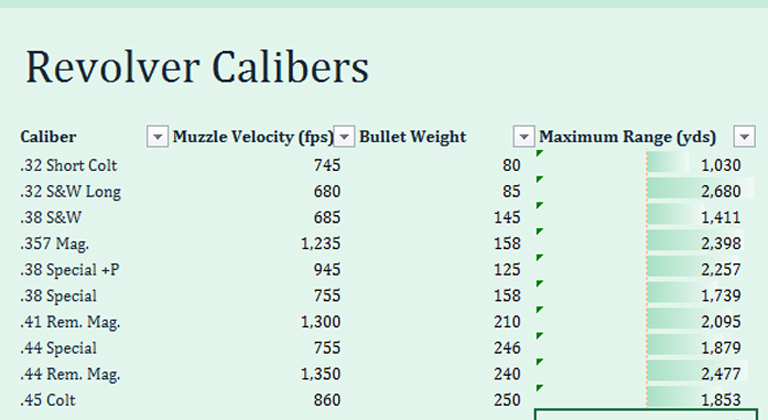A .38 Special bullet can travel a significant distance, potentially reaching over a mile (approximately 1.6 kilometers) under optimal conditions. However, the 38 special effective distance for accurate and controlled shooting is much shorter. This article dives into the factors influencing 38 special bullet travel, its 38 special bullet trajectory, the importance of safety considerations, and what you need to know about the 38 special bullet range.

Image Source: www.nrafamily.org
Factors Affecting .38 Special Bullet Distance
The 38 special bullet distance a bullet can travel is not a fixed number. It’s subject to a range of variables, both internal and external. Let’s explore these critical elements:
38 Special Bullet Velocity and its Impact
The 38 special bullet velocity plays a vital role in determining the bullet’s range. Higher velocity generally translates to a flatter 38 special bullet trajectory and a longer 38 special maximum range. However, several factors influence velocity:
- Ammunition Type: Different loads (bullet weight and powder charge) create varying velocities. For instance, a +P (higher pressure) load will have a greater velocity than a standard pressure load.
- Barrel Length: A longer barrel allows for more complete powder burn, resulting in increased velocity. Shorter barreled revolvers will produce lower velocities.
- Bullet Weight: Lighter bullets generally achieve higher velocities, while heavier bullets have lower velocities but potentially better ballistic coefficient, affecting long-range performance differently.
Environmental Conditions
External factors significantly impact the 38 special bullet travel and 38 special maximum range.
- Air Resistance: Air slows the bullet down. A bullet’s shape (ballistic coefficient) determines how well it cuts through the air. Round-nosed bullets, common in .38 Special, aren’t as aerodynamic as pointed bullets used in rifles.
- Wind: Wind can drastically affect the bullet’s path, causing it to drift horizontally and vertically.
- Altitude: Higher altitudes have thinner air, which reduces air resistance and can increase 38 special bullet range.
- Temperature: Temperature can affect powder burn rate and therefore velocity. Extreme temperatures can impact performance.
Gravity and Trajectory
Gravity constantly pulls the bullet downwards. The initial velocity and angle of the barrel determine the 38 special bullet trajectory.
- The bullet follows a curved path, not a straight line.
- The point of impact changes with distance; you must adjust your aim to compensate for bullet drop.
38 Special Ballistics: A Deeper Dive
38 special ballistics encompass the study of the bullet’s behavior in flight. Understanding these concepts is crucial for responsible gun ownership and usage.
Energy and Momentum
- Kinetic Energy: Energy related to motion. The .38 Special bullet carries kinetic energy, which determines its potential to cause damage.
- Momentum: Mass in motion. Affects how well the bullet penetrates a target.
38 Special Bullet Trajectory Explained
- Bullet Drop: The vertical distance the bullet falls due to gravity. Increases significantly with distance.
- Sight Adjustment: Adjusting your sights or using holdover is necessary to compensate for bullet drop and achieve accurate shots at varying distances.
Table of Typical .38 Special Ballistics (Example)
Note that these numbers are approximations and can vary based on the specific ammunition, firearm, and conditions.
| Ammunition Type | Bullet Weight (grains) | Muzzle Velocity (fps) | Muzzle Energy (ft-lbs) |
|---|---|---|---|
| .38 Special 158-grain LRN | 158 | 755 | 200 |
| .38 Special 125-grain JHP | 125 | 945 | 248 |
| .38 Special +P 158-grain LHP | 158 | 890 | 278 |
38 Special Effective Distance vs. 38 Special Maximum Range
It is critical to distinguish between 38 special effective distance and 38 special maximum range.
38 Special Effective Distance
This is the distance at which a shooter can consistently and accurately hit a target of a reasonable size (e.g., an 8-inch circle). For the .38 Special, the 38 special effective distance is generally considered to be:
- Self-Defense: 7-15 yards (21-45 feet). This is the typical range for defensive encounters.
- Target Shooting: Up to 25 yards (75 feet) for experienced shooters.
- This also changes with the barrel length of the firearm used.
38 Special Maximum Range
The 38 special maximum range is the farthest distance the bullet could potentially travel if fired at an optimal angle (typically around 45 degrees). While the 38 special bullet travel could be considerable, accuracy and lethality are greatly reduced at this distance. 38 special maximum range is approximately 1 mile or 5280 feet.
38 Special Lethal Range
38 special lethal range refers to the distance at which the bullet still retains enough energy to cause significant injury or death. This is a complex issue influenced by many variables, including:
- Bullet type (hollow point vs. round nose).
- Target characteristics (clothing, body mass, etc.).
- Shot placement.
Even at longer ranges, a .38 Special bullet can still be dangerous. Therefore, it’s crucial to treat every firearm as if it’s loaded and to follow all safety rules diligently.
Safety Considerations: Beyond the 38 Special Bullet Range
Responsible gun ownership extends far beyond knowing the 38 special bullet range. Emphasizing safety is paramount.
Four Rules of Gun Safety
- Treat every gun as if it is loaded.
- Never point a gun at anything you are not willing to destroy.
- Keep your finger off the trigger until your sights are on the target and you have made the decision to shoot.
- Be sure of your target and what is beyond it.
Safe Shooting Practices
- Know your target and what’s beyond it. This is perhaps the most critical safety rule when considering 38 special bullet travel. Bullets can travel much farther than you might expect, and it’s your responsibility to ensure they don’t strike unintended targets.
- Use appropriate backstops. When shooting at a range or in a safe outdoor environment, always use a backstop designed to stop bullets.
- Be aware of ricochet. Bullets can bounce off hard surfaces, so avoid shooting at such surfaces.
- Store firearms securely. Store firearms unloaded and locked away, separate from ammunition, to prevent unauthorized access.
Legal Ramifications
Firing a gun recklessly or negligently can have serious legal consequences, including criminal charges and civil lawsuits. Always be aware of local laws and regulations regarding firearm use.
38 Special Bullet Range In Feet – Practical Examples
To give you a better sense of the 38 special range in feet:
- 7 yards (21 feet): Typical close-quarters self-defense range.
- 15 yards (45 feet): Maximum effective self-defense range for many shooters.
- 25 yards (75 feet): A challenging but achievable target shooting distance.
- 100 yards (300 feet): Beyond the 38 special effective distance for most shooters, requiring significant skill and practice.
- 5280 feet (1 mile): Approximate 38 special maximum range under ideal conditions.
Factors Beyond the Bullet
While we have discussed the bullet itself extensively, factors relating to the firearm itself play a role in the 38 special bullet trajectory.
The Gun Itself
The gun’s condition and maintenance are paramount to accuracy and safety.
- Barrel Condition: A clean and well-maintained barrel will promote consistent velocities and accuracy.
- Sights: Properly adjusted sights are essential for accurate shooting at any range.
- Trigger Pull: A smooth and consistent trigger pull will help prevent jerking the gun during firing, which can affect accuracy.
- Overall Condition: Ensuring all parts are functioning correctly is vital for safety and performance.
Summary of Key Considerations
The distance a .38 Special bullet travels is determined by various factors, including bullet velocity, environmental conditions, and gravity. While the 38 special maximum range can extend to over a mile, the 38 special effective distance for accurate shooting is significantly shorter. Safe gun handling practices are crucial to prevent accidents and ensure responsible gun ownership. Always be aware of your target and what’s beyond it, and follow all applicable laws and regulations. The 38 special lethal range depends on factors such as bullet type and shot placement.
Frequently Asked Questions (FAQ)
-
What is the maximum range of a .38 Special bullet?
The 38 special maximum range is approximately 1 mile (5280 feet) under ideal conditions.
-
What is the effective range of a .38 Special for self-defense?
The 38 special effective distance for self-defense is typically 7-15 yards (21-45 feet).
-
Can a .38 Special bullet travel through walls?
Yes, a .38 Special bullet can penetrate most common household walls. This underscores the importance of knowing what’s beyond your target.
-
What affects the trajectory of a .38 Special bullet?
Factors such as bullet velocity, air resistance, wind, gravity, and the angle of the barrel affect the 38 special bullet trajectory.
-
Is a .38 Special bullet lethal at long ranges?
While the energy decreases with distance, a .38 Special bullet can still be lethal at extended ranges. It is important to emphasize that even at its 38 special lethal range a .38 Special bullet should be treated as a potential safety hazard.
-
How does bullet weight affect the .38 Special bullet range?
Generally, lighter bullets have higher velocities but may lose energy faster, while heavier bullets have lower velocities but potentially better ballistic coefficient, affecting long-range performance differently.
-
What is the difference between standard and +P .38 Special ammunition?
+P ammunition is loaded to higher pressures, resulting in increased velocity and energy. However, it may also produce more recoil and wear on the firearm.

Hi, I’m Candace Wafford, a travel and food blogger based in Lexington, Kentucky. As a corporate traveler, I’ve had the chance to explore a lot of places, but now I’m on a mission to travel full-time. My goal? To figure out how to take my cat along for the adventure! Here at destinationdorworth.com, I share my experiences and tips on outdoor activities, travel, and of course, the best food spots I come across. I hope my blog inspires you to explore more and eat well on your journeys!
